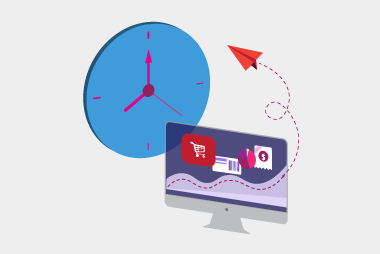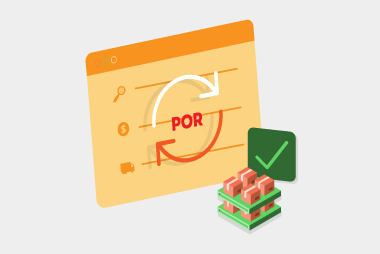Major players in the retail industry have taken advantage of the benefits of electronic data interchange (EDI) over the last 30 years. But there are still some companies that use paper-based procurement. This shows EDI still has potential to deliver even more benefits and savings to the industry.
EDI in the retail industry allows companies to electronically exchange documents like purchase orders, despatch advices, invoices and other documents with suppliers. It replaces the manual process of sending these documents via email, fax and other ways of communication. Businesses in the retail industry generally issue a high volume of orders and EDI helps to improve operational efficiency and reduce the turnaround time to process purchase orders and invoices. It also has added benefits like providing more visibility and better customer service.
How is EDI used in the retail industry?
EDI is extensively used in the retail industry. This sector uses EDI for procurement, shipping as well as invoicing. In the procurement process, two basic EDI documents are used: purchase order and purchase order response. The buyer sends the purchase order to the supplier and the supplier then sends the purchase order response back to the buyer. This tells the buyer what can be fulfilled. In the second stage, shipping, the main EDI document used is the advance shipping notice. The supplier sends the ASN to the retailer to notify them about the shipment. It tells the buyer things like what’s being sent in each package, when it’ll be sent, by whom and more. In the final stage, the supplier issues an EDI invoice and sends it to the retailer. The retailer’s accounts payable team can generate an EDI remittance advice and send it to the supplier to confirm payment.
Why is EDI important in the retail industry?
Customer demands for good quality products, competitive deals and low prices have grown enormously, but the expectation for fast delivery has increased more than ever. Retailers today struggle to keep up with the high delivery frequency and keep count of stock (SKUs). EDI helps in automating this process. EDI purchase orders enable retailers to specify store destination with quantities of each product in a single document, the supplier, on the other hand, processes these purchase orders, ships products directly to the stores and sends advance shipping notice with details of products and quantities being shipped. It is because of this EDI process that retailers are able to fast track the delivery process, have visibility of SKUs and reduce human errors and turnaround time.
There are also benefits when it comes to receiving invoices. For retailers who receive thousands of invoices a month, the time it takes to enter each invoice into their accounting software can really add up. Not to mention it opens the floodgates to mistakes being made. It’s easy to do a quick calculation of what this might cost a business by multiplying the number of invoices by the time it takes to enter each one by staff members’ salary. It all adds up. Some retailers use scanning or optical character recognition (OCR) but this is usually error-prone and can chew up time just fixing the errors. These processing figures can be slashed if a retailer uses EDI to receive invoices directly into their software. It’s like magic.
EDI gives a competitive advantage to companies in the fast-moving retail sector. The Good Guys approached us with the aim to get their suppliers trade electronically with them. They saw EDI as a strategy to have an edge over their competitors. Learn more on how MessageXchange helped The Good Guys achieve this objective and get tremendous results
here.
Benefits of EDI for retailers, suppliers and distributors
It reduces errors and saves costs
Traditional procurement involves a lot of manual processes. There is a potential for expensive errors with every instance of human intervention. EDI eliminates manual work, automates the process and reduces transaction errors by 30 to 40 percent. Retailers and suppliers can save costs and reduce errors with EDI integration. They can save up to 90 percent of invoicing costs with EDI.
Shorter transaction times
EDI messages can be exchanged in minutes in contrast to the paper-based documents which can take days to be delivered. These reduced cycles lead to faster invoice processing and improved cash flow. Retailers receive EDI invoices directly into their software so they can process them quickly and efficiently. Target, an Australian department store that operates more than 300 stores in the country, wanted to achieve visibility and remain current and transparent in the fast-moving retail industry. Read how MessageXchange helped Target achieve their goal
here.
It frees up time for staff to spend on more valuable tasks
EDI in the retail industry helps to automate processes and lets employees focus more on higher value tasks. Instead of spending time data entry, your staff can spend time on more strategic work to help your business grow. EDI helps both retailers and suppliers to streamline their business process and use their resources mindfully.
EDI documents used in the retail industry
[vc_column width="1/4" css=".vc_custom_1618271818355{padding-right: 10px !important;}"]
Message Types
Purchase Order
Purchase Order Response
Invoice
Despatch Advice
Remittance Advice
Product Catalog
Functional Acknowledgement
[vc_column width="1/3" css=".vc_custom_1628228479994{padding-right: 10px !important;padding-left: 10px !important;}"]
Description
Sent from buyer to supplier to order goods or services
Sent from the supplier to the buyer to let them know how much of the order can be fulfilled, and any discrepancies from the original order
Sent from the buyer to the supplier for payment of the goods or services
Sent from the supplier to the buyer to let them know when and how the goods will be shipped
Sent from the buyer to the supplier to confirm payment
Sent from the supplier to the buyer with up-to-date product and pricing information
An automated response sent from a receiver of an EDI message to confirm receipt of the message
[vc_column width="1/6" css=".vc_custom_1628228971532{padding-right: 10px !important;padding-left: 10px !important;}"]
ANSI X12
850
855
810
856
820
832
997
[vc_column width="1/6" css=".vc_custom_1628229725830{padding-right: 10px !important;padding-left: 10px !important;}"]
EDIFACT
ORDERS
ORDRSP
INVOIC
DESADV
REMADV
PRICAT
CONTRL
If you want to learn more about how EDI works in the retail industry, have a look at our
case studies or request a call back from our EDI experts below.
Request a call
Chat with one of our experts
Just fill out your details below and we'll be in touch within one business day.


